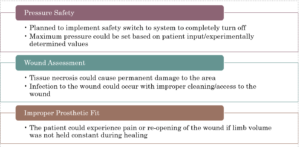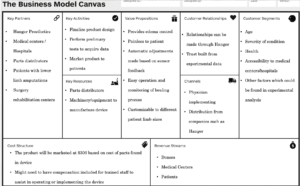Update on 3/27/20
This week, due to the transition to working virtually, we focused on the tasks given by our instructor to strengthen and give fullness to the model we created while on campus.
Predictive Failure Model:
We predicted the way in which the model we had created might encounter issues when implemented in a clinical setting. Amongst the concerns that we had, the main potential points of failure were: giving inaccurate measurements, patient discomfort, lack of customizability, and not properly having the right balance of controlling edema and allowing perfusion of the skin. In terms of inaccurate measurements, we did not get time to fully test the sensors and especially in a trial on a patient, so we are uncertain if these will act as expected and could be a point of failure. The model was also not worn by a patient and could be very uncomfortable, which could be an issue since it would need to be worn for a very lengthy period of time. We didn’t have the opportunity to assess a model that would be customizable for a wide variety of patients, so we could predict some issues arising due to various sizes/health of patients or their surgeries. And finally, the amount of pressure applied by the device would have to fall into a very specific and small range that would prevent edema but still allow oxygen to access the wound. Without previous work to base this value off of, we needed to determine if this was possible experimentally. Since we are unable to do so, this is a very possible point of error in our project.
Safety Analysis:
We also were tasked with observing the possible safety mechanisms included in our device, and the risks associated with it. In analyzing the safety of our device, we concluded that it would approximately be classified as a Class II device by FDA regulations. This is because the device would not be life threatening, but could cause significant harm to the patient if not operated properly. Below is a diagram of the various safety features and risks associated with our device.

Business Model Canvas:
We were tasked with creating a business model canvas, for promotion and distribution of our device. The model is shown below:

Marketing Analysis:
This week we also performed a marketing analysis to give the team a better understanding of how big the market for the Smart Shrinker is. Additionally, the team worked to develop a marketing strategy to help spread awareness of this new technology and get it into the hands of those that need it. The primary demographic that we will be targeting with the Smart Shrinker are the physicians that will be interacting first hand with the patient. To target this demographic, we hope to leverage our current relationship with Dr. Curci and Hanger Prosthetics as well as publish our research and findings in an academic journal.